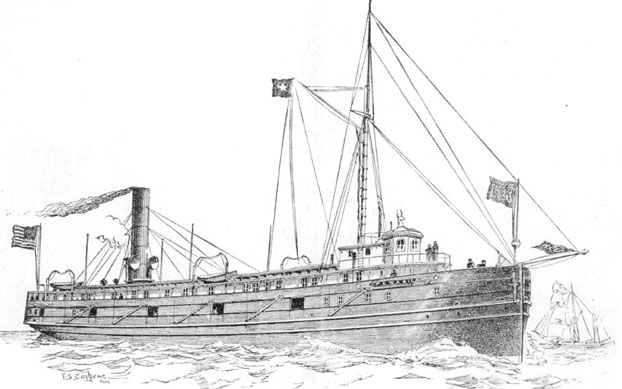
|
| Pewabic |
Why Did They Collide?
The collision that sank the steamer Pewabic and took an estimated 100
lives in Lake Huron's Thunder Bay in 1865
is still counted among the worst of the lake disasters. It also remains among the unsolved mysteries of the Great Lakes.
It
happened when a sister boat, the Meteor, collided with the Pewabic, sinking her at dusk, about 8:30 p.m. on August 9. The
mystery is why experienced sailors aboard the two vessels from the Lake Superior Line could have made such a mistake. The
lake was calm, the night was clear, and survivors from the Pewabic said they could see the light of the Meteor coming for
miles before the collision.
The officers on the two boats had little comment about the accident but historians have
developed a plausible theory. Sailors in 1865 were hungry for news from home, and the best way for them to get it was to buy
and exchange newspapers. The boats, especially the ones affiliated with the same company, often passed newspapers on to each
other when they met so the sailors could get the latest news from the ports still lying ahead of them. The busy boat masters
weren't willing to bring their vessels to a stop just to exchange newspapers so it was said some lines established a system
of throwing papers and possibly even mail from ship to ship as they passed in mid-lake.
The Pewabic and the Meteor
were on a schedule and probably passed each other regularly at the same place on every trip. Nobody can prove it, but the
theory is that the masters brought their boats recklessly close in passing so the papers could be exchanged. On the night
of Aug. 9 they got too close.
The Pewabic, under the command of Capt. George McKay, was coming down the lake, bound
for Detroit, with about 175 passengers and crew members, plus a heavy cargo including 170 tons of copper ingots aboard.
The
Meteor, loaded with lime, was upbound for Lake Superior.
Some stories said Capt. Thomas Wilson and the Meteor's first
mate, George Cleveland, who was standing watch, were negligent in the disaster. But old news stories of the period show that
a jury acquitted Cleveland of any wrongdoing. Wilson testivied that he was not in the wheelhouse at the time of the crash.
The
Meteor not only got too close, it literally rammed the ill-fated Pewabic b roadside. The Meteor drove its bow deep into the
port side of the Pewabic, just aft of the wheelhouse. Many passengers were crushed in the main cabin where they were socializing
for the evening.
The Pewabic filled and sank so fast that crew members caught below in the engine room, and passengers
who failed to get out of their staterooms immediately, were carried to the bottom with the boat.
Some survivors escaped
by jumping to the deck of the Meteor before it backed away. Others got in lifeboats or were picked up in the water by lifeboats
launched from the Meteor.
Survivor James M. Buchan of Cleveland said he was standing with several other passengers
on the deck, watching the approaching Meteor, until it became evident that the two boats were going to hit. He said everybody
ran to the starboard side where they heard the crash. "It didn't shake the boat very much," Buchan said.
He said he
went to his stateroom, grabbed a life jacket, then went out on deck again to assess the damage. By then the Pewabic was already
going down by the head. Before he knew it, Buchan said he was in the water and being pulled down by the suction from the sinking
boat.
"When I began to ascent I felt pieces of timber above me and touching me all around. I began to fear that I could
come under a piece of the deck and find it difficult to come to the surface. But owing to my having a life preserver in my
hand, I came up more rapidly than the wreck and found myself on top of the water with a large piece of the hurricane deck
under me," Buchan said.
The exact number of the dead was never told. Estimates ranged between 40 and a hundred.
The
Pewabic sank deep, in 180 feet of water off Alpena. Even there, the Pewabic continued to claim lives. Her cargo of copper,
plus an estimated $40,000 in the strongbox, tempted many divers to risk the dangerous descent to the wreck. At least five
divers lost their lives before salvagers successfully recovered the Pewabic's treasures in 1917.
The Meteor caught
fire and burned two days after the accident and even before it completed its own ill-fated trip into Lake Superior. The boat
burned in the St. Mary Ship Canal basin near Sault Ste. Marie.
It was said the fire was caused by the boat's leaking
hull, which caused water to make contact with the cargo of lime. To extinguish the flames, the Meteor was scuttled and sunk
in 12 feet of water. No lives were lost.
|

